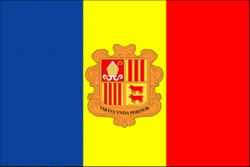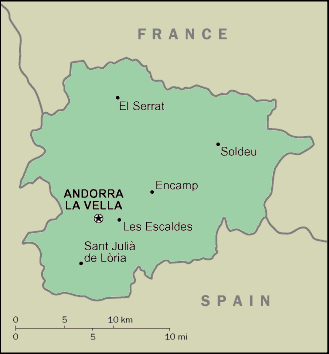Traveling Luck for Andorra. Andorra, Europe
Andorra is located in Southwestern Europe, between France and Spain.
Land in Andorra is rugged mountains dissected by narrow valleys.
Andorran land covers an area of 468 square kilometers which is 2.5 times the size of Washington, DC
Andorra has borders with Spain for 63.700000000000003km and France for 56.600000000000001km.
 Andorran national flag (Flag of Andorra)
Andorran national flag (Flag of Andorra)
As for the Andorran climate; temperate; snowy, cold winters and warm, dry summers.
Andorran(s) speak Catalan (official), French, Castilian, Portuguese.
Places of note in Andorra
 Andorran map
Andorran map
Regions of Andorra
For 715 years, from 1278 to 1993, Andorrans lived under a unique co-principality, ruled by French and Spanish leaders (from 1607 onward, the French chief of state and the Spanish bishop of Urgel). In 1993, this feudal system was modified with the titular heads of state retained, but the government transformed into a parliamentary democracy. Long isolated and impoverished, mountainous Andorra achieved considerable prosperity since World War II through its tourist industry. Many immigrants (legal and illegal) are attracted to the thriving economy with its lack of income taxes.
Tourism, the mainstay of Andorra's tiny, well-to-do economy, accounts for more than 80% of GDP. An estimated 11.6 million tourists visit annually, attracted by Andorra's duty-free status and by its summer and winter resorts. Andorra's comparative advantage has recently eroded as the economies of neighboring France and Spain have been opened up, providing broader availability of goods and lower tariffs. The banking sector, with its partial "tax haven" status, also contributes substantially to the economy. Agricultural production is limited - only 2% of the land is arable - and most food has to be imported. The principal livestock activity is sheep raising. Manufacturing output consists mainly of cigarettes, cigars, and furniture. Andorra is a member of the EU Customs Union and is treated as an EU member for trade in manufactured goods (no tariffs) and as a non-EU member for agricultural products.
Andorran natural resources include hydropower, mineral water, timber, iron ore, lead
landlocked; straddles a number of important crossroads in the Pyrenees
Andorran religion is Roman Catholic (predominant).
Natural hazards in Andorra include avalanches.
Travel Advice for Andorra
AndorraSUMMARY
- Andorra shares with the rest of Europe a threat from international terrorism. Attacks could be indiscriminate and against civilian targets.
- Andorra is not a Member of the European Union and therefore EU reciprocal medical arrangements do not apply.
- Around 120,000 British nationals visit Andorra every year. Most visits are trouble-free. The main type of incident for which British Nationals require Consular Assistance in Andorra is for hospitalisation and Winter Sport associated incidents.
- We strongly recommend that you obtain comprehensive travel and medical insurance before travelling. You should check any exclusions, and that your policy covers you for the activities you want to undertake. Please see: Travel Insurance.
- Visitors to ski resorts should take advice on weather and avalanche conditions before they travel and throughout their visit, please see : http://www.goski.com/andorra.htm and http://www.avalanches.org.
SAFETY AND SECURITY
LOCAL LAWS AND CUSTOMS
ENTRY REQUIREMENTS
HEALTH
GENERAL
You should be aware that off-piste skiing is highly dangerous. All safety instructions should be followed meticulously given the dangers of avalanches in some areas. Further information can be found at the following websites:

 Search
Search Andorra country profile
Andorra country profile Travel advice for Andorra
Travel advice for Andorra